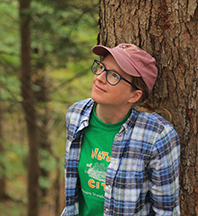Week of October 2, 2022 – October 8, 2022
by Anna Stunkel, Environmental Educator
As summer turns to fall, many of the fields here at Baltimore Woods gradually become carpeted in gold. Along with the crimson, orange, yellow, and violet colors of autumn leaves, blooming goldenrod adds a pop of color to the landscape. There are many different species of goldenrod, all belonging to the aster family. Not only are meadows of goldenrod awe-inspiring; many wonders can be found when taking a closer look at their flowers.
If you look closely at a flower cluster, you’ll notice that it’s made up of many small, daisy-shaped individual florets. Goldenrods are visited by a great variety of pollinators, including bees, wasps, beetles, and butterflies. As beloved Monarch butterflies journey south towards Mexico, goldenrod nectar provides a vital food source. Black-and-yellow striped Locust Borer beetles can often be found on goldenrods pollinating them as well.
Goldenrod provides food for an enormous number of insect species. One 1948 study even found 241 insect species on Canada Goldenrod in just one year! Some of these are specialists that need to feed on goldenrod to survive. Many kinds of flies and other insects create galls on goldenrod stems. The larvae secrete chemical compounds that spur additional growth on the stem, forming a ball in which the insects can live and feed. The insects inside of these galls provide a food source for birds such as Black-capped Chickadees and Downy Woodpeckers.
Some predatory invertebrates take advantage of goldenrod’s yellow color to camouflage and sneak up on their prey. For example, several species of yellow crab spiders hang out on goldenrod. Spiders often live on earlier blooming milkweed plants first, then build their nest sacs close to goldenrod plants. Once the milkweed flowers die, goldenrod blooms, and the spiderlings hatch, they have a good area in which to hunt. Ambush bugs are very well-camouflaged with goldenrod, and although they may be tiny, they will eat prey as large as bumblebees and butterflies! These members of the assassin bug family have strong front legs that they use to capture prey.
As frosty nights arrive and fall days become chillier, the goldenrod’s flowers give way to fluffy seedheads. One flowering stem can produce as many as 10,000 seeds, and they are dispersed by floating on the breeze. Although the golden colors have faded by this time, on a sunny day the fluffy seedhead clusters can have an ethereal glowing appearance.
Goldenrod is very adaptable and can be found along disturbed roadsides as well as sunny open fields. Next time you discover a patch of these flowers, take a moment to study the plants. Maybe you’ll notice a little ambush bug waiting for prey or spot a gall growing on a goldenrod stem.


